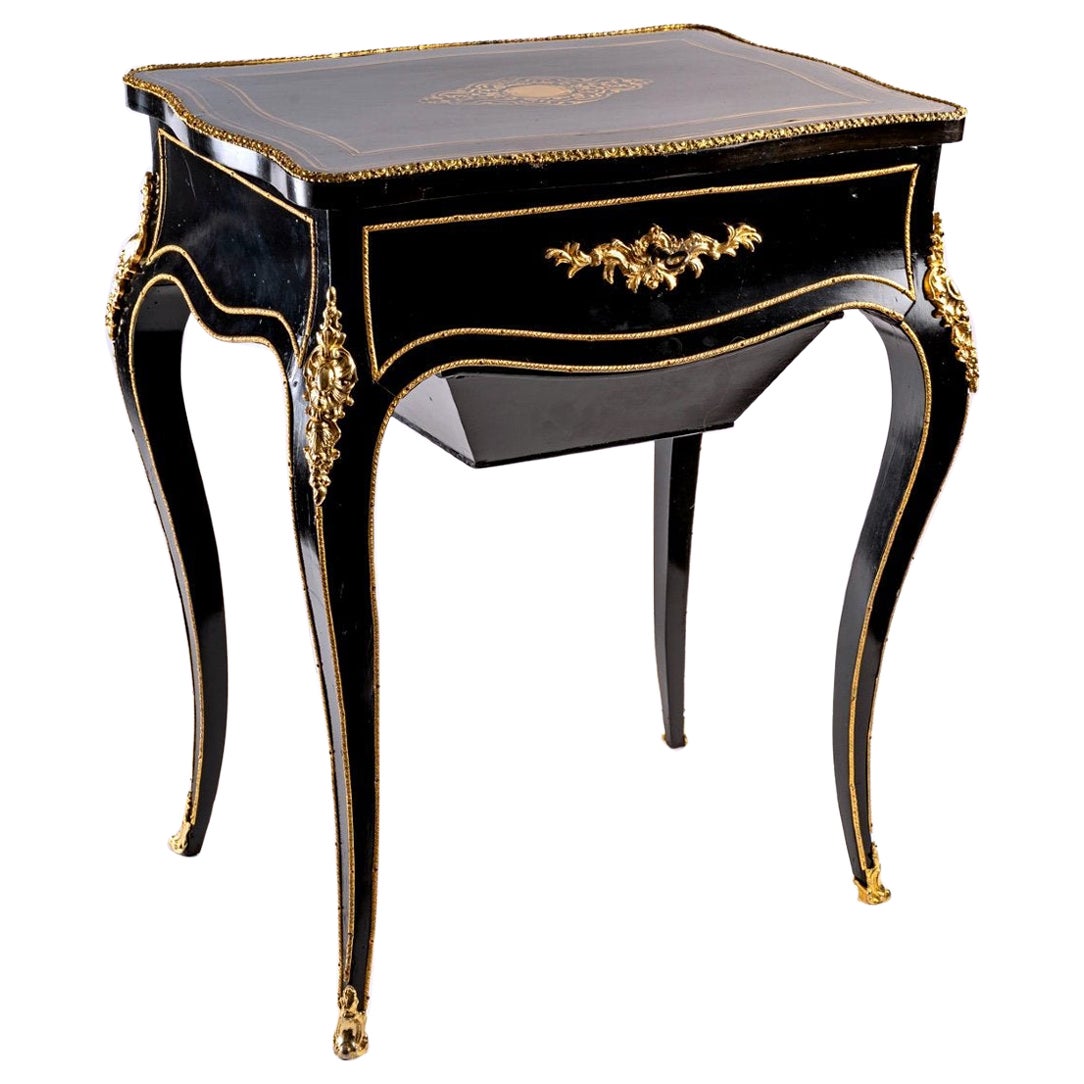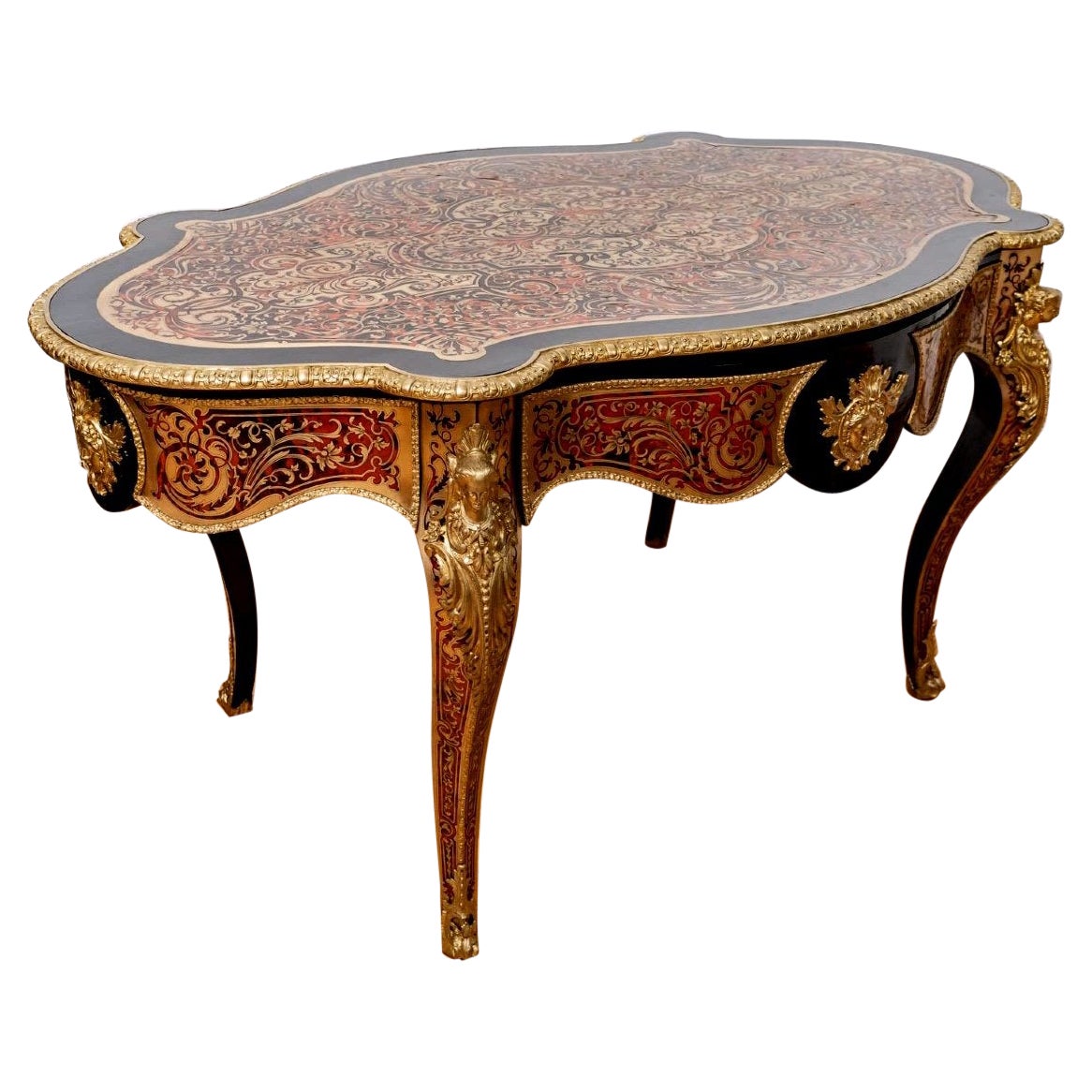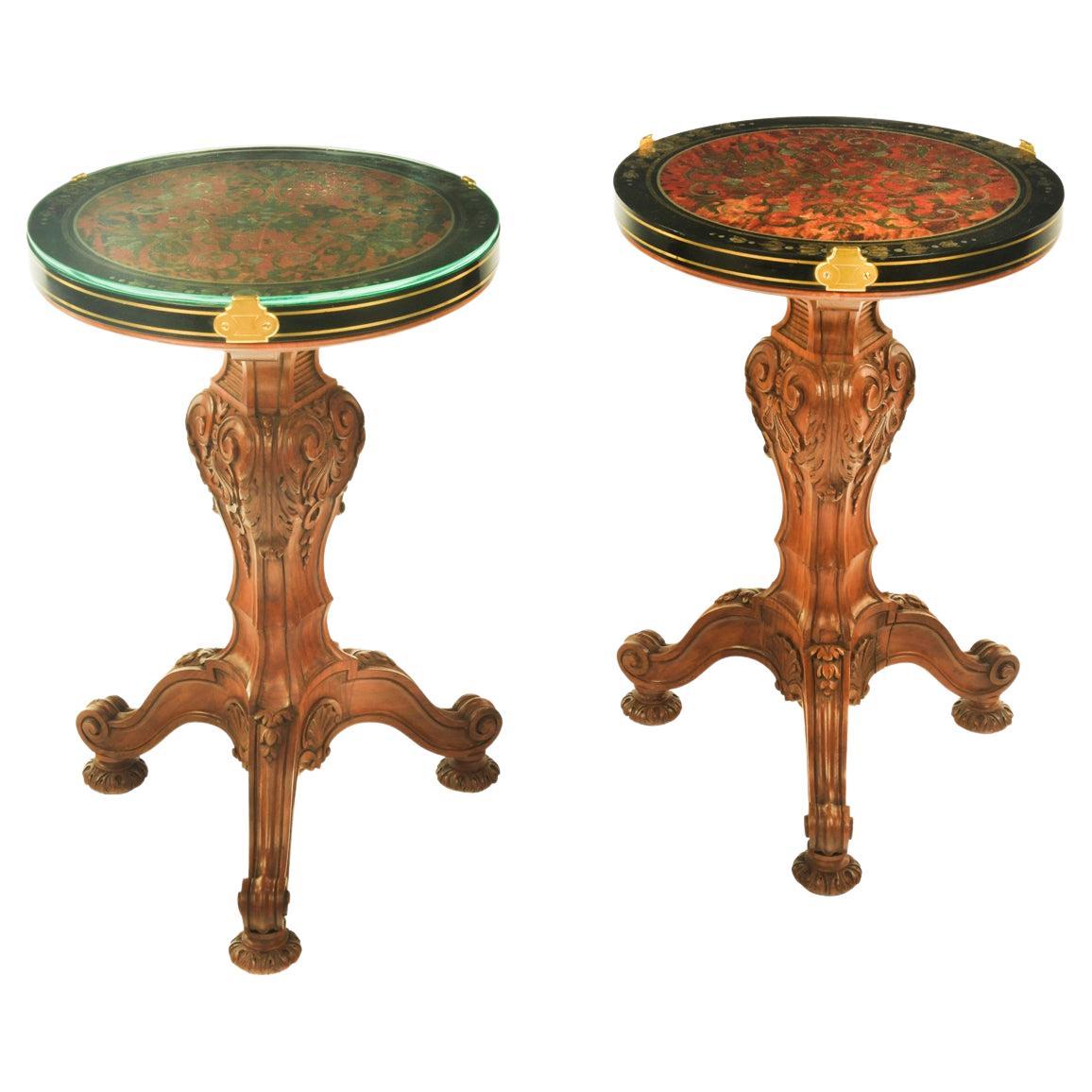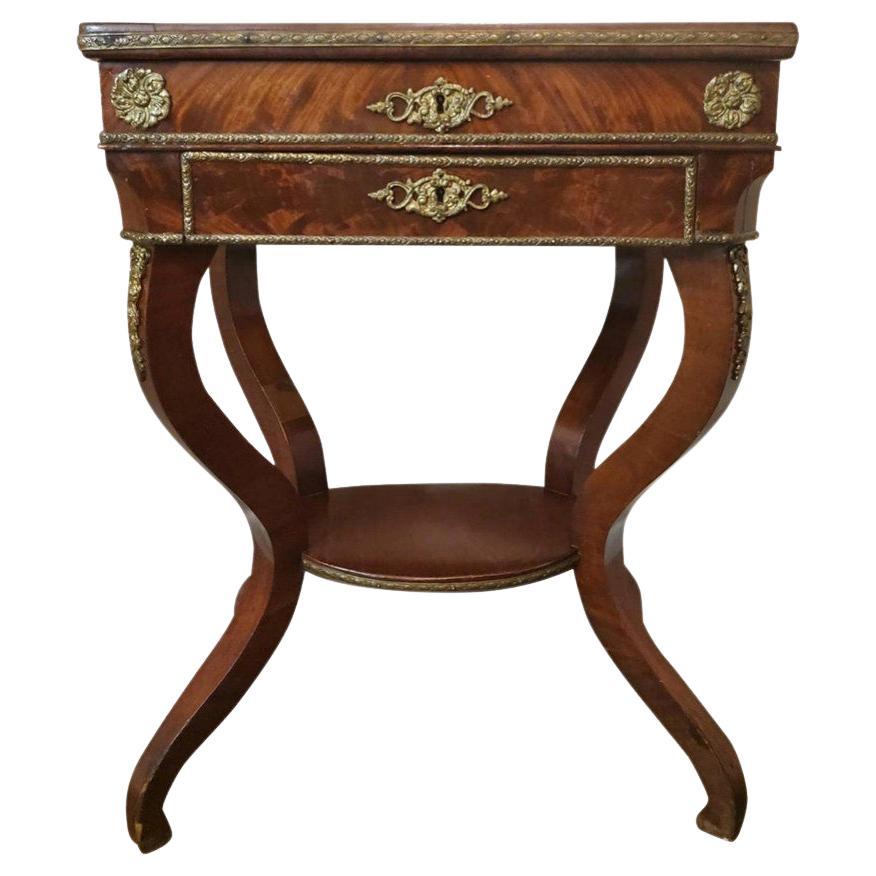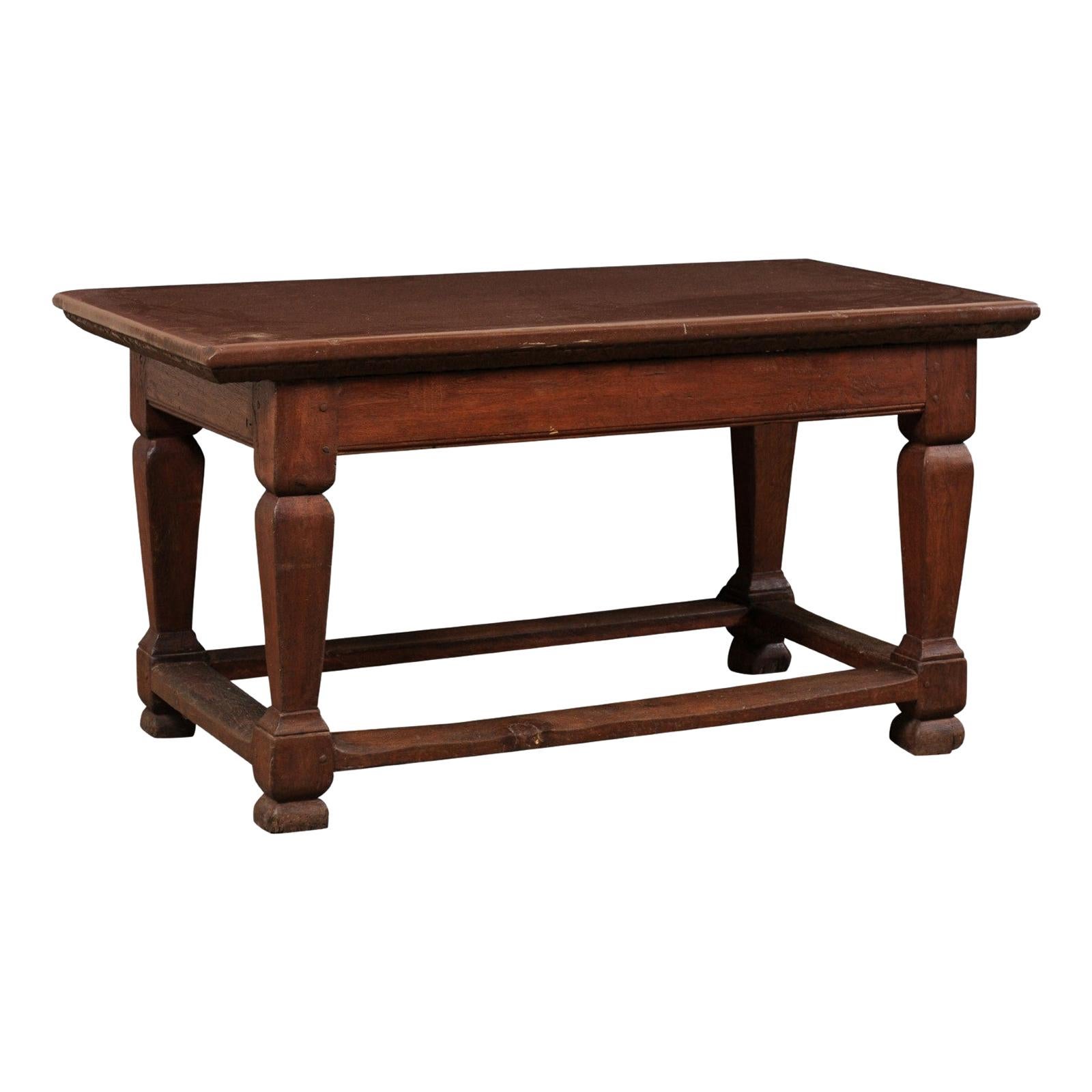Items Similar to Boulle Work Table - Stamped: L.gradé & Pelcot - Period: XIXth
Want more images or videos?
Request additional images or videos from the seller
1 of 8
Boulle Work Table - Stamped: L.gradé & Pelcot - Period: XIXth
About the Item
In the 19th century, under the reign of Napoleon III (1852/1870) in particular, marquetry was rediscovered.
We copy the styles of previous centuries; so we make a lot of Boulle style furniture.
The richness and the quality of the materials are the same but the execution benefits from technical progress: the quality of the furniture of the end of the XIX is superior to that of their ancestors.
Here is a rare work table in gilded brass marquetry on a blackened and lacquered pear tree background.
Its lively scalloped top, surrounded by an ingot mold, is adorned with a cartouche opening onto a rosewood interior with a vanity mirror and a belt drawer. In the lower part, a hopper drawer remains invisible below.
Its feet are curved with ornamentation in chiseled and gilded bronze.
Period: Second half of the 19th century.
Dimensions: H: 72 x W: 63 x D: 43cm.
Stamped: L.Gradé & Pelcot,
A work table, also called a worker, it is a small light table whose top is surrounded by a high border to prevent falling objects.
The work table or worker is a small table that can be recognized by its removable flat or rounded top containing storage.
This table with or without crotch shelf sometimes has a sliding book box under the belt. Louis Gradé set up his workshops in 1852 at 9, rue Caste and in 1856, he opened a store at 23, rue de la Paix in Paris.
He participated in the London Universal Exhibition of 1851 with an honorable mention.
From 1866, the house took the name of Louis GRADÉ ET PELCOT.
They will both participate in the Universal Exhibition of 1867. At the end of the 19th century (1886) the prestigious Boulle school was created, which is now the Higher School of Arts Applied to the Furniture Industries and Interior Architecture.
- Dimensions:Height: 21.26 in (54 cm)Width: 24.81 in (63 cm)Depth: 16.93 in (43 cm)
- Style:Napoleon III (Of the Period)
- Materials and Techniques:Wood
- Place of Origin:France
- Period:Mid-19th Century
- Date of Manufacture:XIX th
- Condition:
- Seller Location:CRÉTEIL, FR
- Reference Number:1stDibs: LU7814236340692
About the Seller
4.0
Vetted Seller
These experienced sellers undergo a comprehensive evaluation by our team of in-house experts.
1stDibs seller since 2022
9 sales on 1stDibs
Typical response time: Several days
- ShippingRetrieving quote...Ships From: CRÉTEIL, France
- Return PolicyA return for this item may be initiated within 14 days of delivery.
More From This SellerView All
- Boulle Work Table, Stamped: L.Gradé & Pelcot, Period: 19th CenturyBy GradéLocated in CRÉTEIL, FRIn the 19th century, under the reign of Napoleon III (1852/1870) in particular, marquetry was rediscovered. We copy the styles of previous centuries; so we make a lot of Boulle style furniture. The richness and the quality of the materials are the same but the execution benefits from technical progress: the quality of the furniture of the end of the XIX is superior to that of their ancestors. Here is a rare work table in gilded brass marquetry on a blackened and lacquered pear tree background. Its lively scalloped top, surrounded by an ingot mold, is adorned with a cartouche opening onto a rosewood interior with a vanity mirror and a belt drawer. In the lower part, a hopper drawer remains invisible below. Its feet are curved with ornamentation in chiseled and gilded bronze. Period: Second half of the 19th century. Dimensions: H: 72 x W: 63 x D: 43cm. Stamped: L.Gradé & Pelcot, A work table, also called a worker, it is a small light table whose top is surrounded by a high border to prevent falling objects. The work table or worker is a small table that can be recognized by its removable flat or rounded top containing storage. This table with or without crotch shelf sometimes has a sliding book box under the belt. Louis Gradé...Category
Antique 19th Century European Napoleon III Industrial and Work Tables
MaterialsBrass
- Ceremonial Table Marquetry André Boulle - Violin Shape - Period: XIXthBy André-Charles BoulleLocated in CRÉTEIL, FRTable of violin form, with structure in blackened pear tree, almost completely covered with a marquetry 'Boulle'. This technique, which consists of a superposition of Red Tortoisesh...Category
Antique 19th Century French Napoleon III Tables
MaterialsFruitwood
- Secretaire Dit De Dame - Stamp: Romain Magniant - Period: XIXth CenturyLocated in CRÉTEIL, FRA sumptuous "Lady's" secretary in burr cedar and blackened pearwood. This magnificent piece is the work of a 19th century cabinetmaker and gilder, Mr Romain MAGNIANT, the stamp is pr...Category
Antique 19th Century French Napoleon III Secretaires
MaterialsWood
- Living Room Library Table, Jacques Adnet, Elm and Leather, Period: XxthBy Jacques AdnetLocated in CRÉTEIL, FRCoffee table forming magazine rack of Jacques Adnet. The structure in elm decorated with leather. He directed the Compagnie des Arts Français from 1928 to 1960. His furniture wit...Category
Vintage 1950s French Tables
MaterialsLeather, Elm
- Solid Wood Set - Stools & Table - Jean Prouvé & Pierre Janneret - Period: XXthBy Pierre Jeanneret, Jean ProuvéLocated in CRÉTEIL, FRDelightful set in solid wood, composed of a coffee table and a pair of tripod stools works realized in collaboration by two major actors of the French modernism in the XXth century. ...Category
Vintage 1940s Stools
MaterialsWood
- Bean Shaped Dressing Table - Thuja Burl And Rosewood - Period: Art DecoLocated in CRÉTEIL, FRA delightful kidney-shaped dressing table in burr cedar, rosewood and light wood veneer. It stands on a spindle base enhanced by four ormolu sabots. It opens with a drawer in the wai...Category
20th Century French Louis XV Tables
MaterialsRosewood
You May Also Like
- Period Regency Rosewood Work TableLocated in Hudson, NYThis fine work table made in England, circa 1810 is of an unusual sculptural form and relates to the work of George Smith one of the periods most influential designers. Made of a sar...Category
Antique Early 19th Century English Regency Tables
MaterialsRosewood
- Pair of Small Walnut Tables with Boulle-Work Tops by PillininiBy PillininiLocated in Lymington, HampshireA pair of small walnut tables with Boulle-work tops by Pillinini, each with a circular top decorated with brass and pewter marquetry, embellished with black penwork, inlaid into a to...Category
Vintage 1950s French Side Tables
MaterialsBrass, Pewter
- 19th C. French Charles X Restoration Period Sewing Stand Work TableLocated in Forney, TXA scarce period Charles X (1818-1834) French Restoration mahogany travailleuse sewing (thread stand - side table - jewelry dressing table) with light, warm, beautifully aged patina. Born in France in the early 19th century, almost certainly Parisian work, exquisitely hand-crafted, this exceptionally executed example features ornate gilt bronze ormolu mounts, escutcheons, and elaborate gilt metal trim. Having a highly figured light mahogany hinged lid top, lifting open to reveal a striking finished interior with divided compartments and original inset mirror plate. The conforming rectangular case fitted with a faux drawer front over a dovetailed drawer with sectioned interior. Elegantly rising on oval-shaped medial shelf stretcher-joined curvacious legs. Dimensions (approx): 27" High, 20" Wide, 13.5" Deep Stunning light almost blonde antique mahogany coloring and mellow warm tone, superb wood grain detail, and charming, beautifully aged patina over the whole. Great shape overall. Retaining original antique character marks, wear consistent with age and indicative of minimal use, nothing that detracts from the aesthetics or functionality, but only adds to the overall authenticity, refined elegant warmth, luxurious sophistication, and cozy unpretentious rustic elegance. Delivered cleaned, hand waxed, polished French patina finish, ready for immediate use and generational enjoyment! What is Charles X style: The comte d’Artois – or Charles X - was the son of the dauphin Louis-Ferdinand de Franc and Marie-Josèphe de Saxe. He succeeded his two brothers Louis XVI and Louis XVIII and became the King of France in 1824. Thirty years after the French Revolution, he wanted to embody the return of monarchy and became the leader of the catholic party . As the previous kings, he was crowned in 1825 but he was soon overthrown by the revolution in July, 1830, called "Trois Glorieuses". He left then for England, Scotland, Prague and Istria where he died in 1836. Charles X style lasted from 1818 to 1834 and happened during the Bourbon Restoration (French Restoration). This style did not replace totally the style of furniture from the French Empire but it was different from the formalism in the Napoleonic era, during which strictness and simplicity were inspired by Greco-Roman art. Indeed, artistic fields flourished. In terms of furniture, this renewal was suggested by the softening of shapes. Even though the simple aspect from the French Empire was still visible, shapes became curvier with volutes and arabesques. Another distinction is the loss of the massive aspect of furniture and the decrease of dimensions in order to decorate smaller appartments. Handling ability and comfort were key-words in the making of furniture. Apartments had essential elements such as chests of drawers, big rounded tables in the dining room, desks or secretaries, armoires and even dressing tables, comfortable fainting couches in the living room, small tables, pedestal tables, as well as gondola chairs. The wavy aspect of the latters certainly represent Charles X style the best. One of the most emblematic features of this style is the use of bois clairs – light woods in warm blond tones - and indigenous woods that are varnished in order to highlight the grains. Bird's-eye maple, ash trees, plane trees, yew trees, beech trees, olive trees and cedar trees were most likely to be used. Indeed, at the beginning of the 19th century dark woods were hard to find. In 1806, the Napoleon’s Continental System was established in order to ruin the United Kingdom by preventing the country from any business with the rest of Europe. Therefore craftsmen had to find alternatives from mahogany which was the most commonly used material at this time. After 1815, the import of wood was even more difficult because of peace treaties and the European political situation, which contributed to the popularity of the bois clairs and indigenous woods. The furniture was often decorated with fine inlays made out of dark wood representing foliage, which contrasted with the veneer. Even though these patterns can look like bronze decorations from the Empire era, they were far more simple and did not represent any military or mythological attributes. On the tables, trays were sometimes made out of marble as in the French Empire, but it was often put aside and inlaid veneer, Verre Eglomisé – a type of glass with a mirror finish –, mirror or porcelain from Sèvres or Paris were more likely to be used. Decorative elements from the Monarchy were highly appreciated again as they suggested luxury. Indeed, marquetry work was particularly fashionable - Boulle marquetry thrived around 1820 as the works of the Levasseur family can show. In the same way, draperies and trimmings referred to the monarchist splendour. Fabrics were often white – the traditional colour of the Bourbons – or light coloured as oppposed to the typical green from the Napoleonic era. One of the most symbolic figures from this period of time might be Jean-Jacques Werner (1791-1849), a cabinetmaker who worked for prestigious clients such as the Duchesse de Berry who was Charles’s step-daughter. His works can be seen at the Musée des Arts Décoratifs and at the Grand Trianon in the Palace of Versailles. The duchess’s appartments situated at the pavillon de Marsan and at the Palais de Saint Cloud illustrate Charles X style the best with furniture made out of bois clairs and ornamented with dark wood patterns or fine gold decorations. Chales X style allows a transition between the sobriety of the Empire style and the abundant aspect of Louis-Philippe style. The gothic style started at this time through the "style à la cathédrale", inspired by religious architecture, which thrived from 1827 to 1830. Indeed, at the beginning of the 19th century, Romanticism put the spotlight on the Middle Ages. Cabinetmakers were not inspired by the medieval furniture but rather by architectural elements of churches and cathedrals. For instance the backs of chairs were decorated with arches shaped like rib and serration. In the same way, before Charles X abdicated, pieces of furniture were made out of dark woods – such as mahogany, which was used again in France – and were inlaid with light wood. Romanticism also influenced the layout of furniture in appartments to suggest movement through a mix of various styles, various shapes and various sizes, as opposed to the static aspect of Neoclassicism. The start of industrialisation and mechanisation also influenced this style as early technical developments led to the production of pieces of furniture in series. Credit: Marc Maison Bibliography: FANIEL Stéphane (Dir.), Le Dix-neuvième Siècle Français, Collection Connaissance des Arts, 1957, Hachette SASSONE, Adriana Boidi, Furniture from Rococo to Art Deco, 2000, Evergreen -- Extremely versatile: As warm and attractive as it is useful, this remarkable antique table having the ideal size and small proportions for a variety of different uses, including as a side table, accent or occasional table, tall sofa...Category
Antique Early 19th Century French Charles X End Tables
MaterialsBronze, Ormolu
- 18th C. Swedish Period Baroque Table w/Stone Top- A Great Kitchen Work Table!Located in Atlanta, GAA Swedish period Baroque stone top table from the early 18th century. This antique kitchen table from Sweden features it's original stone top, ...Category
Antique Early 18th Century Swedish Baroque Industrial and Work Tables
MaterialsStone
- Antique 19th Century French Boulle Centre Table, circa 1860Located in Suffolk, GBAntique 19th century French boulle centre table. The serpentine shaped top features all-over tortoiseshell and profuse inlaid brass decoration, qua...Category
Antique 1860s French Napoleon III Center Tables
MaterialsBrass, Bronze
- Paul Sormani Exotic Amboyna Work TableBy Paul SomaniLocated in London, by appointment onlyExceptional 19th century work table by Parisian ébénist, Paul Sormani. France, circa 1870 Measures: Width 59cm - 23.25in Depth 41cm - 16.2in Height 73cm - 28.75in - Incredib...Category
Antique Late 19th Century French Napoleon III Side Tables
MaterialsAmboyna
